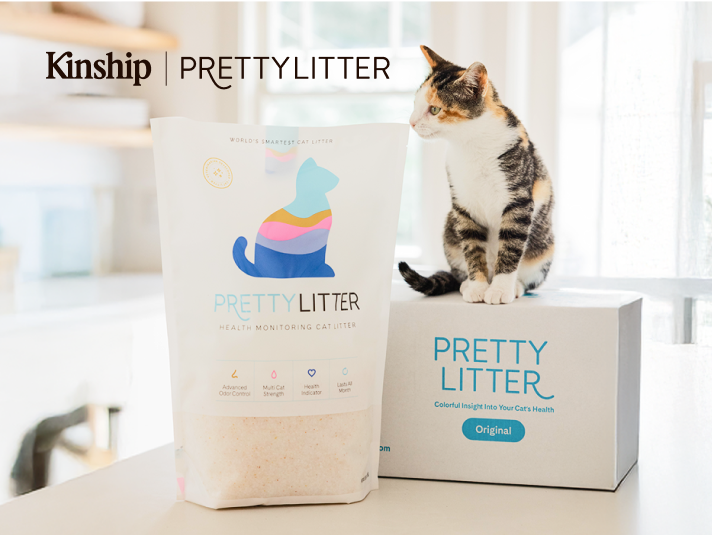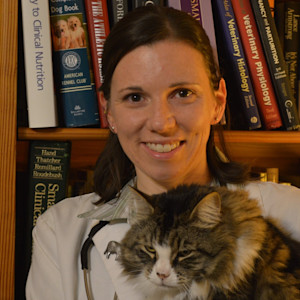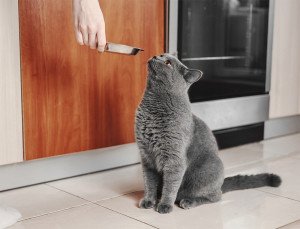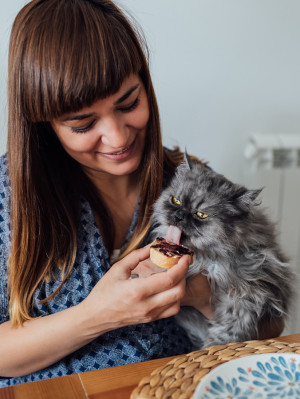Is Wet Or Dry Food Better For Your Cat?
We go over the pros and cons of both.

Share Article
In This Article:
What Is Wet Cat Food?opens in a new tab What Is Dry Cat Food?opens in a new tab Which Type of Food Is Best to Feed Your Cat?opens in a new tab Can You Feed Your Cat Both Types of Food?opens in a new tab What Do Veterinarians Recommend For Wet And Dry Cat Foods? opens in a new tab
Wet or dry? Canned versus kibble? These are questions cat parents often ask themselves when trying to provide their kitty with the best nutrition option possible. So, what’s the verdict? Unfortunately, this veterinarian is here to tell you the answer isn’t that easy. What’s best for your cat may not be best for your neighbor’s cat, and a cat’s needs can change with time.

Save on the litter with color-changing tech that helps you better care for your cat.
What is wet cat food?
Wet or canned cat foods are common entrees for our cats. They come in tantalizing flavors, such as fish, chicken, and even cheeseburger. Most cats go absolutely bonkers for canned food, and they can be provided as a full meal deal or a tasty treat.
How wet cat food is made
Wet, canned food is made by mixing meats, vegetables, sometimes grains, and other ingredients, sealing them in a can, and cooking the can to remove bacteria that could promote spoilage.
Pros of wet cat food
Wet cat food has a higher moisture content than dry food, hence the name. It may also be more enticing to most cats as it can have a stronger scent and taste than dry food.
Cons of wet cat food
Wet cat food can spend nearly a lifetime unopened on your pantry shelf, but once you break that seal, you have a finite amount of time for your cat to consume it. Opened cans also need to be stored in the refrigerator, spoiling within a few hours if left at room temperature.
Wet cat food is also typically more expensive than dry food.
What is dry cat food?
Dry cat food, or kibble, is the type that comes in bags of various sizes. It’s poured into a bowl like cereal and can have different shapes and colors than the ingredients it’s made up of.
How is dry cat food made?
Meats, vegetables, fats, grains, and other ingredients are mixed and cooked at high temperatures when making dry cat food. The product is then extruded through a machine and cooled to make the shapes of the kibble we’re familiar with. From there, fats or carbohydrates may be sprayed on the kibble to increase the tastiness.
Pros of dry cat food
Dry cat food has a long shelf life, even when opened. Open bags of food will last for weeks, and kibble can be left out at room temperature all day without danger of spoiling. Dry cat food also tends to be less expensive.
Cons of dry cat food
Generally, dry cat food is more processed than wet versions. However, that’s not always true as pate formulations are smooth and creamy rather than rich and chunky.
Which type of food is best to feed your cat?
It’s impossible to say if one type of food is better than the other for all cats; every cat is different. So, let’s explore which food suits which type of cat best.
Types of cats best suited for wet food
With benefits such as higher water content and increased palatability, it would make sense that wet cat food is best suited for picky eaters. Picky eaters can include cats who have strong preferences for aromatic and flavorful food. We all know a cat who has more uppity tastes than others, and wet cat food may be just what their finicky tastebuds ordered.
Also, dental disease can make eating more of a chore for cats who have it so they may appreciate the softer textures of wet cat food. Wet cat food may also be the most enticing choice for cats with kidney disease or other health issues that can lead to nausea and a decreased appetite.
Speaking of kidney disease, these kitties need all the fluids they can get, so wet cat food can be a way of sneaking it into them. Diabetes and feline lower urinary tract disease (opens in a new tab) are a couple of other issues that benefit from a higher fluid intake as well.
Types of cats best suited for dry cat food
Because dry food can be left out for longer hours than wet cat food, it’s a good choice if you have a grazer rather than a gobbler. Dry food also works better for automatic feeders or puzzle toys, and though most veterinarians won’t recommend allowing your cat to graze all day (also called “free choice feeding”), dry cat food is really the only option for it.
With a lower price tag, dry cat food may be the best choice if you have to watch your budget, and it can be purchased in bulk, potentially lowering the price even more.
Can you feed your cat both types of food?
If you’re still unsure about which food is best for your kitty, don’t worry; You don’t have to choose. Some cats do really well eating both. That way you can get the benefits of each and offer your cat a little variety as well.
There are many ways to feed both dry and wet cat food. You may choose to mix them together with every meal or feed one in the morning and the other in the evening. Just make sure that you’re giving the recommended amounts of each for maintaining a healthy weight and not overdoing it with either version.
What do veterinarians recommend for wet and dry cat foods?
If you ask five different vets which cat food they recommend, you’ll likely get five different answers. Choosing the right cat foodopens in a new tab is difficult because there are so many cat foods available, and we all develop our “favorite” for our own reasons.
With this in mind, you can start by choosing a food that’s approved by the Association of American Feed Control Officialsopens in a new tab (AAFCO). This organization outlines the basic nutritional guidelines that a pet food must meet in order to keep an animal alive. An AAFCO approval doesn’t necessarily mean that a food is high quality, just that it should meet a cat’s minimum nutritional needs. Food that isn’t AAFCO-approved may be lacking nutrients.
Next, look at the ingredients list for whole foods, such as meats, grains, and vegetables. While you might not recognize every ingredient listed, the first four to five should be familiar. Generally, whole ingredients are more nutritionally packed and easily digestible, meaning your cat will actually get what they should out of them.
You’ll also want to take your cat’s specific needs and preferences into account. If your cat is crazy about chicken but not wild about fish, a seafood flavor might not be the best option. If they need a little more moisture in their diet and don’t like the hard crunch of kibble, then wet food will likely be in your future.
Of course, your finances play a role as well. If you can’t afford the food or you can’t reliably get your hands on it, it’s no good for your cat. Remember that you’ll hopefully have your kitty for the long haul, so choose a food that fits your budget for years to come.
References
Cornell University College of Veterinary Medicine. “Feeding Your Cat.” Cornell University College of Veterinary Medicine, 16 Oct. 2017, www.vet.cornell.edu/departments-centers-and-institutes/cornell-feline-health-center/health-information/feline-health-topics/feeding-your-catopens in a new tab.
“Feline Lower Urinary Tract Disease (FLUTD).” American Veterinary Medical Association.https://www.avma.org/resources-tools/pet-owners/petcare/feline-lower-urinary-tract-diseaseopens in a new tab.

Dr. Chyrle Bonk, DVM
Dr. Chyrle Bonk has been a mixed animal veterinarian since 2010. When she's not practicing or writing about veterinary medicine, you may find her exploring the outdoors with her family or tending to her cows, horses, chickens, or cats and dogs.
Related articles
![Woman feeding her puffy cat at the table.]() opens in a new tab
opens in a new tabWhat Human Foods Can Cats Eat?
We know they’re begging—but what’s safe to share?
![Cat asking for human food from counter]() opens in a new tab
opens in a new tabWhat Can Cats Eat Besides Cat Food?
Good news for your begging cat: Some of your favorite snacks are safe to share.
- opens in a new tab
How Long Can Wet Cat Food Sit Out?
Your new cat certainly isn’t going to have the answer.
![A woman feeding food to her cat at a dining room table]() opens in a new tab
opens in a new tabIs Homemade Cat Food Good for Your Kitty?
The best ingredients to include when considering a home-cooked diet for your cat.
![a fluffy cat eating food from a bowl]() opens in a new tab
opens in a new tabDo Cats Need High-Calorie Cat Food?
Why you should only be packing on the calories in certain situations.
![Close up view of a person's hand feeding a gray cat with food]() opens in a new tab
opens in a new tabDoes Your Cat Really Need to Go Grain-Free?
You’ve got questions. Dr. Bruce Kornreich, director of the Cornell Feline Health Center, has answers.







